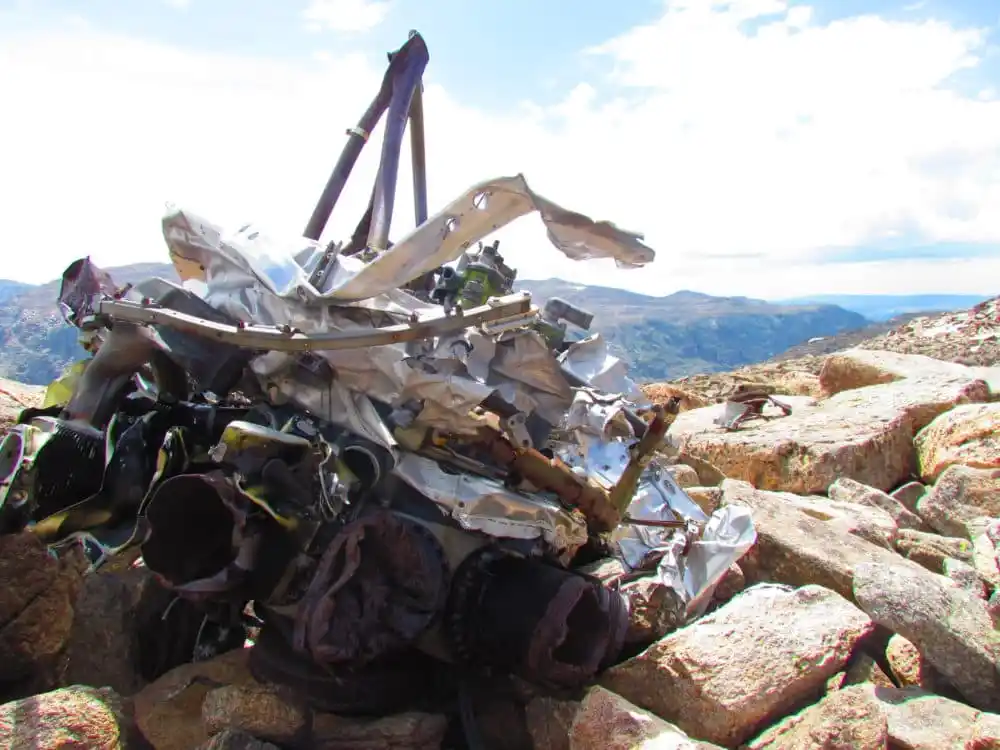For a good portion of my adult life, I’ve been working within the Wyoming roller derby community. The first time I ever heard of Bomber Mountain was when a new roller derby team in the region chose the name “Bomber Mountain Derby Devils-” a group of a bunch of awesome ladies and gents who even put on a special game just for Longmire Days in the summer.
Buffalo, you see, is the inspiration for the fictional town of Durant in the Longmire mystery novels by Craig Johnson, on which the TV series is based. He even named the fictional county of Absaroka, where the eponymous sheriff serves his brand of justice.
Nearby buffalo, you can also find the Crazy Woman Creek, named for another tragedy when a woman witnessed her husband being scalped by local native americans and subsequently “lost her mind.”
A few miles into the Bighorns, one can even find a Native American medicine wheel, and important spiritual site from prehistoric days that is still used for tribal ceremonies.
While the names and locations near Bomber Mountain are unique and exciting, one can probably surmise why the mountain has the name it does— Was there a bomber in the Bighorns once? Let’s find out.
In 1945, two cowboys in the bighorns came across a grisly site– A missing WWII bomber that was meant to go to England for the ongoing war efforts was laying in wreckage near the mountain that would one day bear its name.
The Bomber, which was a B-17 Flying Fortress, had been marked as missing in 1943. Two subsequent attempts by the army to locate the plane had failed, and the plane was marked as lost.
When the two cowboys found the wreckage, they also found the bodies of the deceased crew members. Shortly before going down, the pilot reported their location as near the Powder River region in Wyoming. It’s believed that the poor visibility from the moonless night combined with malfunctioning navigational equipment contributed to the crash. They say the crew likely wouldn’t have known they were on a direct collision course until it was too late. The wreckage was said to have been difficult to find because the green colouring of the bomber blended into the local ridges. It was believed the plane crashed into the side of the 2,841-foot unnamed mountain.

The plan was on its way to Nebraska, where it would meet up with other aircraft for a coordinated flight to England during WWII. The plane carried machine guns and weapons from Oregon on their way to Nebraska. When they didn’t arrive with the other aircraft, they were marked as missing, but weeks of searching yielded no results, as the army didn’t know how far off-course the bomber might have gone.
If you look up at the mountain today, you can sometimes catch a glimpse of the eponymous wreckage of the B-17, the sun reflecting off the metal. One of my favorite museums in the state, the Jim Gatchell Memorial Museum, contains a fabulous exhibit on the bomber’s fate, with memorials to the crew that were lost.
The airplane had 10 crew members when it went down, with no survivors of the accident. The town of Buffalo has erected a memorial to the departed crew on the banks of Florence Lake, just a few miles from the crash site as the crow flies.
That’s how Bomber Mountain in Buffalo was christened with it’s name– a tragedy leading to an interesting historical event that those who were around in the 1940s still speak of with reverence. Right in front of the Jim Gatchell Memorial museum stands a plaque with the names of every member of the close-knit community that served in the armed forces and never came home.
The town of Buffalo is proud and reverent with those lost in the various military engagements across the globe — and especially the ten men who were lost before they could reach the front lines of WWII.
This episode is dedicated to the memory of those men who lost their life that day:

The Pilot was named William R. Ronaghan, a former police officer in the Bronx who enlisted with his two brothers after Pearl Harbor.
Copilot Anthony J. Tilotta, known as Tony, left behind a wife and two children. He had previously been an airplane mechanic before enlisting.
Leonard H. Phillips was the Navigator of the expedition and was only 22. His friends said he was handsome and self assured but had no time for trivial things like a girlfriend.
Charles H. Suppes , known to friends as “Suppie,” was interested in theater and dance.
James A. Hinds was the oldest crew member, at just 25.
Ferguson T. Bell, Jr. was the radio operator and was from Pennsylvania– His voice was the last heard before the plane went down.
Assistant aircraft engineer Lee ‘Vaughn’ Miller had tried to marry his fiance the last time he was on leave, but a bridge was washed out in his home state of North Caroline, preventing the nuptuals.
Charles E. Newburn, Jr was called “junior,” at only 21. He was engaged to be married upon his return.
Aiircraft gunner Jake F. Penick was from a family of Army recruits, as all of this brothers also enlisted.
Lewis M. Shepard was a roller skater, but only to pick up girls. The tall 22 year old wrote to his mother religiously. The day before he died, he wrote to his mother to tell her of his new captain, and how he seemed like a good man
While they never made it overseas to fight in the second world war, these men gave their lives for their country. Due to a navigation mistake, they ended up as legends in the landlocked state of Wyoming. Their memory carries on in museums and on mountain tops.









